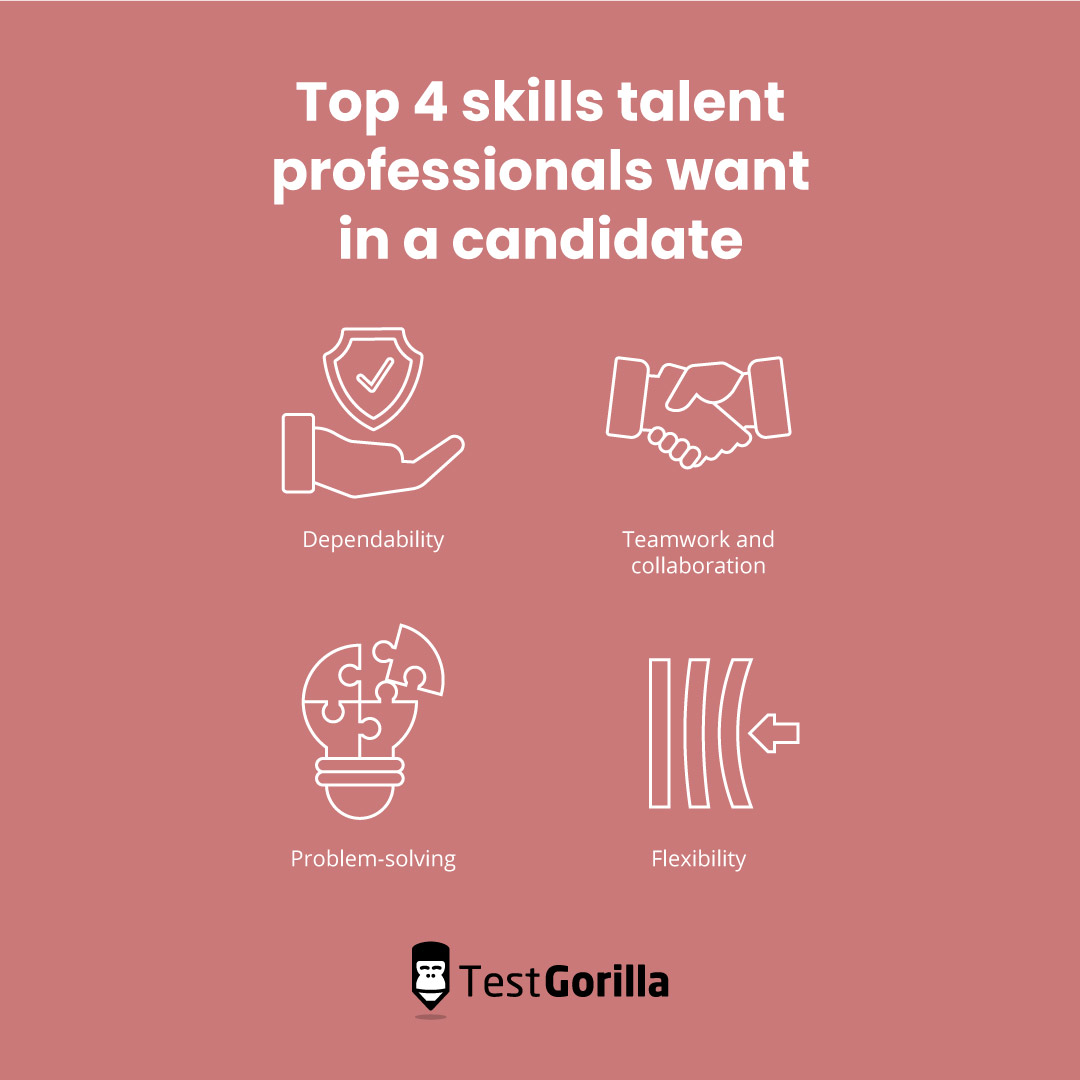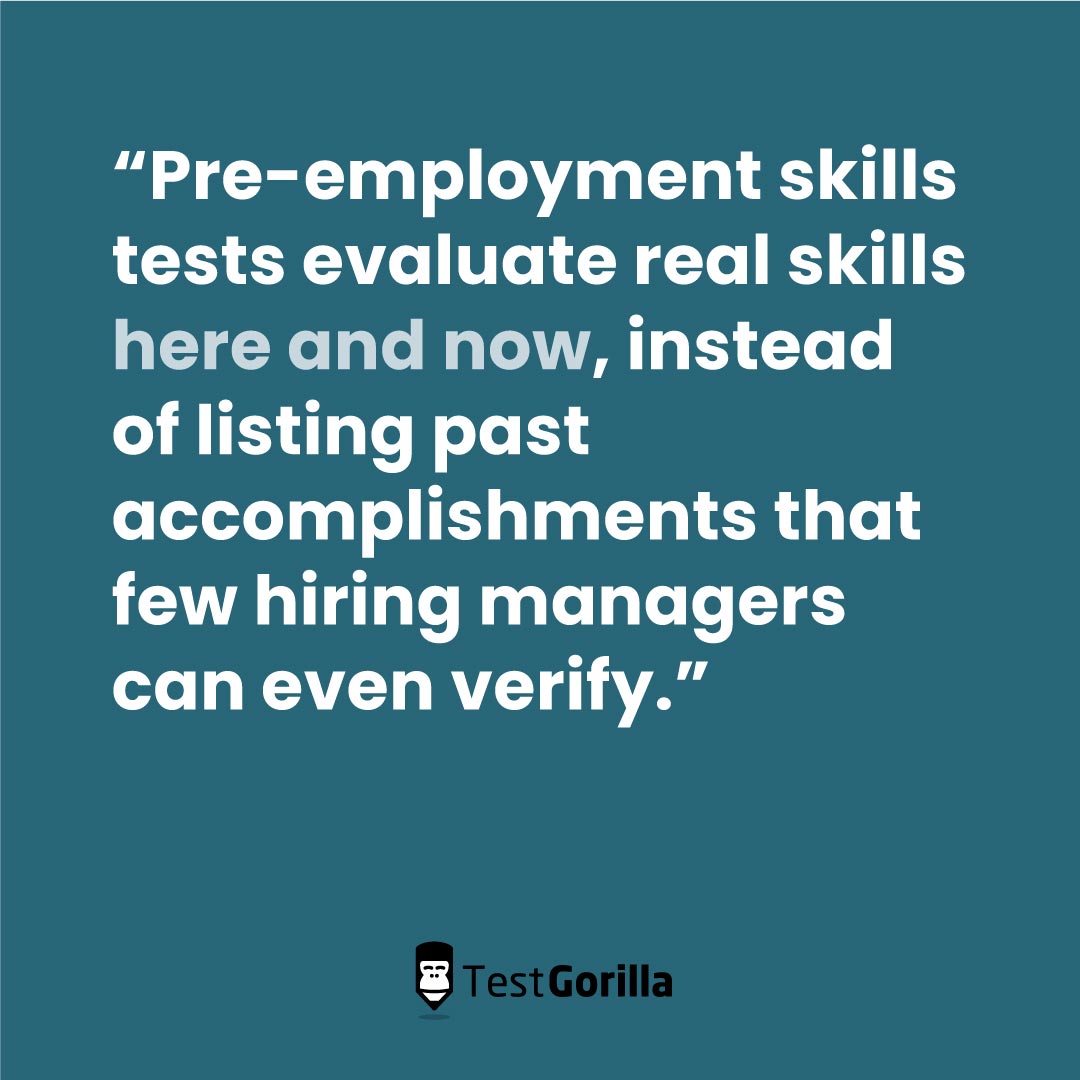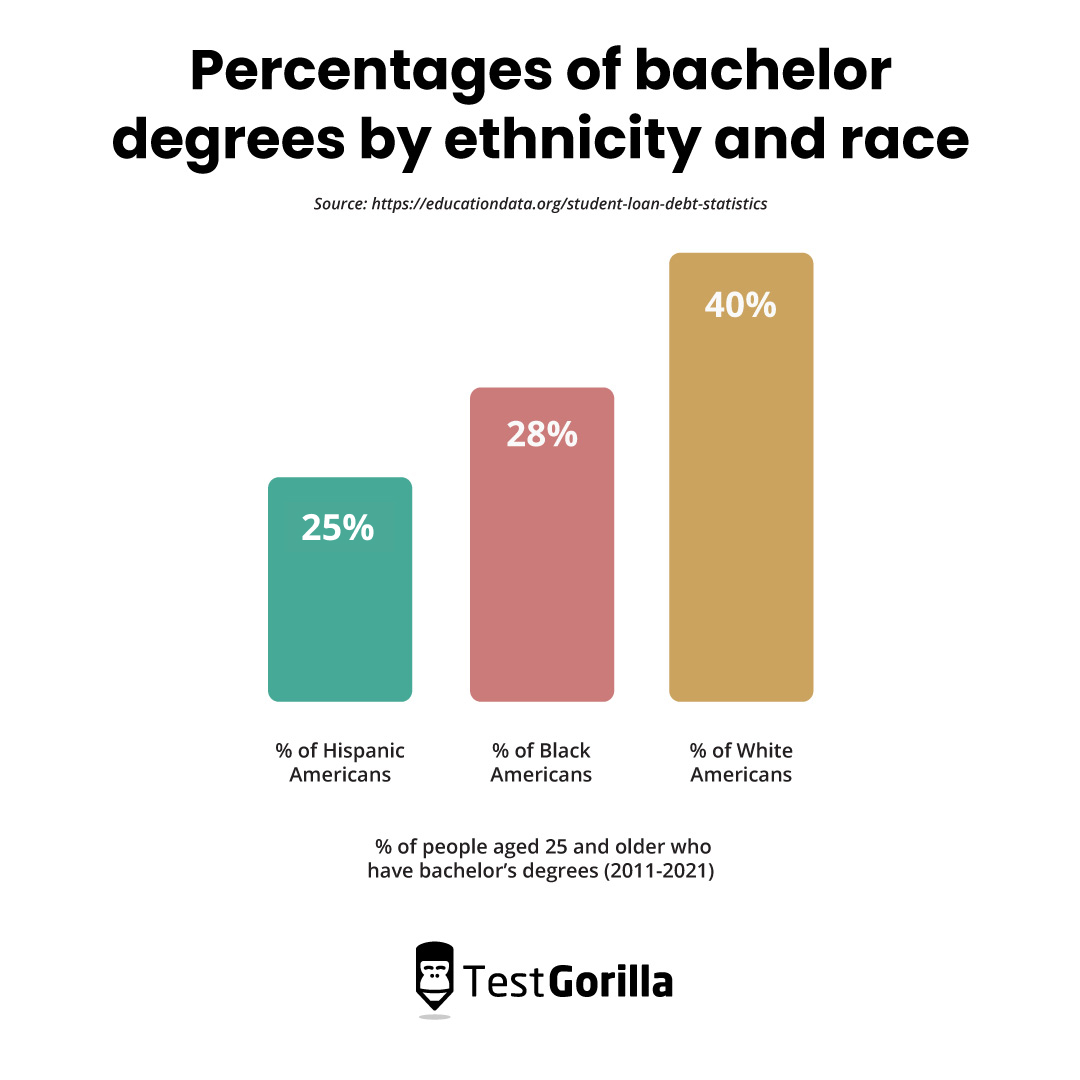Skills testing as part of the holistic hiring process
Candidates are a combination of many traits: ability, personality, knowledge, drive, and attitude. All of these blend together to make the complete package, but they’re simply too complex and nuanced to properly display on a resume.
A holistic hiring process focuses on a candidate as a whole, which means it takes into account more than their professional skill set.
It considers their values, soft skills, and culture add.
Pre-employment skills tests are a natural addition to the recruitment process, enabling hiring managers to evaluate candidates on real capability and raw talent.
They widen your talent pool and provide a solid opportunity to every talented candidate, regardless of their background.
Outdated hiring practices are hindering the holistic hiring process. Resumes are an obstacle for top talent and don’t consider important candidate factors like values and personality.
Let’s talk about skills testing as a part of a modern hiring initiative, its top benefits, and where it sits in the overall process.
Table of contents
- What is holistic hiring?
- What is skills testing, and how does it fit into the holistic hiring process?
- The benefits of skills testing
- Best practices when using skills tests in a holistic hiring process
- How to implement skills testing in your holistic hiring process
- Focus on the whole individual with skills tests
- Sources
What is holistic hiring?
The holistic hiring process evaluates the entire candidate, not just their professional skills. It’s an individual-focused approach that assesses soft skills, worldviews, and values.
Holistic hiring isn’t just about fitting a candidate into a role. It also ensures they align with the company as a whole. This is imperative when soft skills are HR’s top priority right now.
According to The Future of Work 2021, the top four skills talent professionals want in a candidate were all soft skills:
Dependability
Teamwork and collaboration
Flexibility
A holistic hiring process also considers how the candidate complements existing employees and skill sets.
This means that holistic hiring naturally improves diversity in the workplace. Instead of focusing solely on required degrees and skills, it zeroes in on diverse candidates that make your organization flourish.
Imprivata, a security software company, uses a holistic hiring process. Their hiring managers prioritize structured interviews with behavioral questions to create a more individual-focused candidate experience.
Jimena Gamboa Bonilla, Imprivata’s customer success manager, says that as a woman of color, it makes her happy to work with colleagues from nontraditional and nontechnical backgrounds.
She also says that a holistic approach improves the quality of hires, saying that it’s much easier to teach technical skills than it is to teach accountability.
What is skills testing, and how does it fit into the holistic hiring process?
A skills test is an assessment used by hiring managers to evaluate a candidate’s capability to complete job responsibilities. These tests assess how a candidate behaves in work situations and how they respond to normal job tasks.
Pre-employment skills tests evaluate real skills here and now, instead of listing past accomplishments that few hiring managers can even verify.
Assessing a candidate with skills tests carries a myriad of benefits:
Enables a recruiter to see if the candidate can do the job before their first day (something a resume can’t do)
Widens the talent pool to include candidates that don’t have the “right” background
Gives candidates first-hand experience of the type of work they’ll be doing
Skills tests also reach outside the standard definition of “skills” and can assess much more. For example, personality and culture tests assess a candidate’s worldview and preferred lifestyle, and key personality factors like openness and agreeableness.
Assessing an individual through personality and culture tests is indispensable to a holistic hiring process, because knowing if a candidate’s values align with your organization is next to impossible without them.
Skills tests are the future of hiring, but they shouldn’t replace current processes. They are a single but vital part of the greater holistic hiring process.
Pre-employment skill testing should be used to add to a hiring process and update it. For example, they could replace the resume portion, but then you continue to the interview as usual.
The best insights on HR and recruitment, delivered to your inbox.
Biweekly updates. No spam. Unsubscribe any time.
The benefits of skills testing
The benefits of skills testing affect both the candidate and the employer, improving the hiring process from both sides.
Each benefit also complements the holistic hiring style. It’s like skills testing and holistic hiring were made for one another.
Here’s a quick summary of the top advantages of using skills testing:
Benefit | Description |
Reduced bias | Reliance on skills tests instead of resumes removes many opportunities for bias |
This reduced bias widens the talent pool | |
Improved candidate quality | Skills tests are a more reliable indicator of talent than resumes |
Skills tests assess crucial skills before the hire’s first day | |
Ability to assess personality and culture | Skills tests enable you to assess values and worldview, which is essential for a holistic hiring process |
Skill assessments help find alignment between candidate and company culture | |
Better candidate experience | Skills-based hiring provides a smooth, transparent candidate experience |
Skills tests enable candidates to preview work responsibilities before day one | |
Improved brand image | Skills-based hiring is a more fair, talent-focused process, and displaying these values is important to candidates |
This improved brand image naturally attracts more applicants | |
Identify skills for future development | Skills tests enable hiring managers to see areas of improvement before the candidate is even hired |
Hiring managers can use this information to prepare development plans |
Reduced bias
Skills tests enable recruiters to toss away outdated processes that are filled with opportunities for bias, such as:
Educational requirements
Work experience
Native language requirements (requiring native language speakers exclude excellent candidates, but skills tests assess language proficiency)
An overwhelming 81% of employers recognize that unconscious bias affects their decisions, but 42% of companies take no steps to reduce it.[1]
Adopting skills testing is a large step in reducing hiring bias.
Reducing hiring bias also helps expand your talent pool. Using skills tests opens your talent pool to include thousands more stellar candidates who were locked out of previous hiring initiatives.
Four-year degree requirements alone exclude countless candidates, including many people of color. Here are the percentages of bachelor degrees by ethnicity and race:
28% of Black students
25% of Hispanic students
45% of White students
Having requirements for four-year degrees where they aren’t necessary automatically doubles the number of White candidates.
Skills tests enable candidates to join the race who have obtained their skills from alternative means, such as life experience, hobbies, boot camps, or natural ability.
Improved candidate quality
Increasingly, more hiring managers are doubting the effectiveness of resumes.
According to a TestGorilla survey, 38% of HR professionals said that resumes aren’t effective, and a further 6% said they weren’t sure how effective they were.
The same survey showed that 56.9% of respondents said they couldn’t tell if the applicant had the right skills from their resume.
Skills tests are a better and more direct indicator of performance and quality than resumes.
Skills tests enable hiring managers to determine whether or not candidates have essential skills before their first day, which improves candidate quality and reduces the risk of a bad hire.
María Villegas, a junior SEO specialist at TestGorilla, is proof that resumes don’t show true candidate quality, but skills tests do.
María studied medicine for six years before making the switch to SEO, so her resume didn’t accurately reflect her skill in SEO. She had to do free work for family and friends to build up her resume, but she shouldn’t have had to.
TestGorilla let María prove herself through skills assessments and sidestep the entire resume process, which gave her a great job and gave our organization a great hire.
For more stories like María’s, read our article on 10 stories that demonstrate the power of skills-based hiring.
Ability to assess personality and culture
Traditional methods like resumes don’t enable you to evaluate a candidate’s personality and values, which are essential in a holistic approach.
Skills-based hiring harnesses tools such as personality tests to assess a candidate’s worldview, values, and lifestyle to create a better culture add for your organization.
Here are a few personality and culture tests:
Enneagram test: Defines a candidate’s core beliefs and worldview
16 Personalities test: Gives insight into a candidate’s source of energy, how they process information, and how they make decisions
The Big 5 test: Evaluates an individual’s openness, agreeableness, and emotional stability
Culture Add test: Assesses how a candidate aligns with your organization’s culture
Having a candidate who is aligned with company culture is much more important than most organizations believe – it’s the top employee job satisfaction factor across nearly every industry and country.
At TestGorilla, we believe culture is everything, and we believe in culture add over culture fit. This means making an addition to your culture, rather than fitting someone into your culture perfectly.
For more information, read our blog post on culture add vs culture fit.
Better candidate experience
Skills tests offer a more solid, positive candidate experience, which makes happier new hires.
Skills-based hiring practices create a smoother process from the candidate’s perspective, from relying on capability to giving people a sample of their responsibilities and tasks.
Here are a few ways skills tests improve the whole candidate experience:
Being assessed for your skills creates a talent-focused process and gives candidates the opportunity to display their capabilities
Little or no reliance on resumes is a relief to thousands of candidates without the “right” background
They offer candidates a glimpse into how your company works before their first day
Even unsuccessful candidates get an idea of the skills and talent they need for this role, and they can then use this information in future job searches
This means that successful candidates are more prepared for their first day at work, but unsuccessful candidates can walk away with more knowledge and a positive candidate experience.
A positive experience makes unsuccessful candidates more likely to recommend and refer your company to others. One study showed that 82% of job seekers share a positive candidate experience.[2]
A solid, pleasant candidate experience promotes natural referrals and a better brand image.
Speaking of brand image…
Improved brand image
Implementing skills tests enables you to wear your values on your sleeve for all potential candidates to see.
Skills-based hiring is the future. It shows that your organization focuses on real talent, doesn’t place unnecessary importance on degrees, and believes in giving folks with an unconventional background a chance at a great job.
And these values matter to candidates.
A study by Qualtrics showed that 54% of workers would be willing to take a pay cut to work at a company with better values. A further 56% wouldn’t even consider a job offer from a company with values they don’t agree with.
Improving your brand image boosts your hiring initiatives exponentially – 82% of job seekers consider the employer’s brand before applying for a job.
This means that showing your brand’s commitment to skill and capability naturally attracts more job applicants.
Identify skills for future development
Skills tests enable hiring managers to see the skills that candidates excel in – and also the skills that might need improvement.
No one would write their weaknesses or areas of improvement on a resume. Most candidates may not even know which of their skills are “great” and which are “good.”
Skills tests tell recruiters right off the bat where the candidate is strongest, and where the candidate needs to learn and grow. Knowing this in advance enables HR professionals to immediately build learning opportunities into a new hire’s development plan.
That way, you don’t have to gradually find out where a new hire is lacking – you’re already prepared.
Skills tests also help find areas of improvement in internal candidates and employees.
Performing a company skills gap analysis with skills tests enables you to assess current strengths and weaknesses in your team.
This facilitates internal hiring efforts as well as upskilling employees in their current positions.Read our article on the subject to learn more about how to use skills tests to address internal skills gaps.
Best practices when using skills tests in a holistic hiring process
Ready to adopt skills testing? Let’s take a look at the best practices to optimize skills testing in a holistic hiring process.
Here’s a quick summary of the best practices:
Best practice | Description |
Ensure skills tests are used early in the hiring process | Skills testing should always come before resumes |
Resumes can filter out great candidates with nontraditional backgrounds | |
Test only skills relevant to the role | Skills testing should only be used to assess skills needed in the role |
Multi-measure testing enables you to evaluate multiple relevant skills in one assessment | |
Use qualifying questions for positions with strict requirements | Skills tests can still be used for positions with strict requirements, such as medical and legal roles |
Qualifying questions determine whether or not a candidate possesses certain qualities early in the process | |
Incorporate skills tests into a larger hiring process | Skills tests shouldn’t be used on their own and should be part of a larger process |
A skills-based hiring process should still include applications, interviews, and trial samples (where possible) |
Ensure skills tests are used early in the hiring process
Skills testing should be one of the first steps in the hiring process, and always precede resumes. We generally recommend them right after anonymous applications.
If you use tests after resumes, you’re filtering out non-traditional candidates with an excellent skill set that’s not apparent from their educational or professional background.
Doing it the other way around means you’re assessing a candidate’s skills before you even lay eyes on their accomplishments, experience, and certificates, which levels the playing field for every potential hire.
In truth, we believe hiring managers should ditch resumes entirely. With efficient, accurate hiring methods like skills testing, resumes are a thing of the past.
Test only skills relevant to the role
Assessing role-relevant skills is crucial to using skills tests to their fullest.
Some skills aren’t necessary to get the job done well, and focusing on them could distract candidates or skew their assessment results.
For example, using our Communication test to evaluate a project manager is essential. This position needs to be in constant contact with team members and stakeholders.
On the other hand, communication skills may not be strictly relevant for positions that aren’t people-focused, such as backend developers and warehouse workers.
We recommend multi-measure testing, which is the process of assessing multiple dimensions of performance for a role. This usually involves evaluating role-specific hard skills, cognitive abilities, and personality.
Here’s an example multi-measure assessment for a front-end engineer:
Angular test: Role specific
CSS test: Role specific
Critical Thinking test: Cognitive ability
Numerical Reasoning test: Cognitive ability
Culture Add test: Personality and culture
These tests cover a broad range of skills and capability, but are all pertinent to the role of a front-end engineer. This way, you’re assessing exactly what you need in this role, which ensures the candidate is a better fit for the position.
Use qualifying questions for positions with strict requirements
Certain medical and legal positions require educational degrees by law, but that doesn’t mean you can’t still rely on skills tests.
Qualifying questions help you maintain a skills-based approach even with roles that have strict requirements.
These questions enable you to ask if a candidate has certain requirements before they even fill out the application, and disqualify them if they lack the credentials.
Qualifying questions are often used for verifying:
A specific, required degree
Language proficiency
The legal right to work in a country
A valid driver’s license
The ability to work remotely
These questions are used only for non-negotiable qualities. If the criteria are something you can work around or simply improve in a great candidate, we recommend including the criteria as custom questions.
Incorporate skills tests into a wider hiring process
Skills testing shouldn’t be used on its own and should always be a part of a wider process.
Skills tests are an excellent way to assess capability and enable hiring managers to understand a candidate’s skills before they’ve hired them, but more steps are needed.
HR professionals should still utilize applications, interviews, and trial samples (where possible).
Other hiring methods are still necessary to fully evaluate a candidate, such as interviews which help you to get to know a candidate and build a relationship.
Trial samples also give hiring managers a better idea of a candidate’s skill, ability to handle feedback, and the way they work with others.
So how do you incorporate skills tests into a larger holistic hiring process?
How to implement skills testing in your holistic hiring process
We’ll run you through a basic holistic hiring process, enhanced with skills tests.
But first, let’s talk about a holistic approach to your job descriptions and applications.
You can reduce bias and focus on the candidate as a whole by optimizing your job descriptions and applications. Here are a few best practices:
Job descriptions
Remove minimum and maximum years of experience
Remove strict requirements on software proficiency (most software can be learned)
List responsibilities and skills instead of requirements
Applications
Use qualifying questions for strict requirements
Don’t ask for date of birth or date of graduation
Make resumes and cover letters optional
It’s here that skills tests come into play.
Skills testing should come right after the application stage. This is the ideal spot to assess candidates with skills tests, so they come before resumes (if you use resumes at all).
That way, you aren’t filtering out top talent by scanning resumes first.
Let’s take a look at a sample assessment for a marketing manager:
Branding Strategy test: Evaluates candidates’ ability to define, position, manage, and develop a brand
Technical SEO test: Assesses candidates’ skills in analyzing websites and improving their ranking in search engines
Attention to Detail test: Assesses candidates’ ability to pay attention to visual details and information
Leadership & People Management test: Evaluates a candidate’s ability to lead others within an organization
Culture Add test: Assesses how a candidate’s values and behaviors align with your organization’s values
You can see that this is a multi-measure assessment. Multi-measure testing is essential in a holistic hiring process because it examines the candidate as a whole, including technical skills, soft skills, and personality.
After the assessment, it’s time to analyze the results of the top candidates.
Analyzing the results is simple:
Select a scoring benchmark
Set a minimum and maximum score
Filter and sort candidates by field and status
View individual results
This process enables a hiring manager to get a big picture of a candidate. They aren’t just looking at a list of previous work and certificates – they’re seeing their technical capabilities, soft skills, and values first-hand.
No guesswork involved; you’re just looking at scores and percentages.
Skills testing optimizes a holistic hiring process to the point where it’s difficult to imagine it without them.
After this, the hiring process typically moves into interviews. A skills-based holistic hiring process would use structured interviews.
Structured interviews have pre-determined success criteria and a specific set of questions that the interviewer asks every candidate. This enables the interviewer to focus on the individual’s ability to do the job.
They reduce the chance of getting side-tracked and judging a candidate based on their ability to make conversation or joke around – which aren’t tied to job performance.
In fact, unstructured interviews only predict 14% of job performance. Which is why Google dropped them years ago.[3]
Structured interviews, on the other hand, predict 26% of job performance.
Structured interviews are much more skills-focused and unbiased, so they lend themselves perfectly to the process. In fact, many companies already use these to facilitate a holistic hiring process (like Imprivata mentioned above).
To learn more about them, read our blog post on unstructured vs structured interviews.
By incorporating skills tests into the process and using this combination of methods, recruiters can hire a candidate for who they are as a whole.
You can hire your next employee for their skills, personality, values, and what they contribute to your culture.
This also means that the candidate is a great contender for internal mobility, and more likely to stay with your company for years to come.
Focus on the whole individual with skills tests
The holistic hiring process is the perfect way to assess a candidate as a whole and find the perfect person not just for the position, but for your organization in the long run. And the process becomes a well-oiled machine with the introduction of skills tests.
Work experience and degrees are excellent, but they aren’t the only indicator of performance and quality. They also don’t give you the whole identity of the candidate.
The sooner recruiters acknowledge this and kick the resume to the curb, the faster we can improve the candidate experience, quality of hire, and the holistic hiring process.
Sources
“Diversity and Inclusion in Recruitment”. (2017). Robert Walters. Retrieved January 24, 2023. https://www.robertwalters.co.uk/content/dam/robert-walters/country/united-kingdom/files/whitepapers/Diversity-In-Recruitment-Whitepaper-web.pdf
“Candidate Experience Report: Perceptions & Behaviors”. (2019). Talentegy. Retrieved January 24, 2023. https://www.talentegy.com/hubfs/2019%20CX%20Report/Talentegy-2019%20Candidate%20Experience%20Report.pdf
Bock, Laszlo. (April 7, 2015). “Here’s Google’s Secret to Hiring the Best People”. Wired. Retrieved January 24, 2023. https://www.wired.com/2015/04/hire-like-google/
You've scrolled this far
Why not try TestGorilla for free, and see what happens when you put skills first.






















